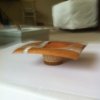I hope it's OK to start a new thread. I have a bit of a different problem this time. So I decided to try the square bowl again, I really wanted a different profile than what I had achieved with the first completed bowl (see post titled Square Turning Part 2 on this thread http://www.aawforum.org/vbforum/showthread.php?11357-What-did-I-do-wrong-Chip-out-on-square-turning) . I wanted a downturn on the wings, more like a bird wing or leaf shape. I succeeded in getting that but the interior of the bowl had a pronounced "hump" where the transition was (see the first pic). The profile (pic 2) looks right to me but the interior of the bowl does not. I corrected the hump with an hour of sanding but that's not what I want to do in the future. The hump appears right where the bowl stops being solid (where turning in air begins) I think I may have just been too gun shy to keep the tool cutting consistently, but I'm not really sure. Again, any suggestions are appreciated.
Mark


Mark










